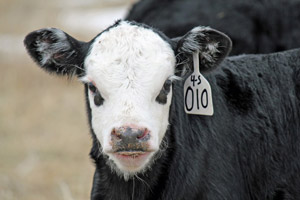Definite Advantages to Calves Born in the First 21 Days of the Calving Season
January 2015

As the calendar turns over, cow calf producers begin to think about the upcoming spring calving season. The length of the calving season is important, but when the calves are born during the calving season is also important. There are definite advantages for calves born in the first 21 days of the calving season. The most obvious benefit is the ability to market larger, more uniform groups of heavier calves, resulting in a larger payoff at sale time.
However, the advantages of having calves born early extend beyond the simple differences in weaning weight. Research from the University of Nebraska conducted by Dr. Rick Funston, has demonstrated that steer calves born in the first part of the calving season had higher valued carcasses with greater marbling scores (UNL Extension 2010 Nebraska Beef Cattle Report, PDF document). In addition, his work also shows that heifer calves born during the first 21 days of the calving season had greater weaning, pre-breeding and pre-calving body weight. There were also a greater percent cycling before breeding and greater pregnancy rates compared to heifers born in the third period (UNL Extension Beef Cattle Report).
Early calving also has an impact on the cow. Early-calving cows are more likely to become pregnant in the next breeding season and early-calving heifers tend to remain in the herd longer than heifers calving after the first 21 days.
University of South Dakota research by L.K. Kill et al. in 2012 (http://go.unl.edu/itni) on a group of 2,195 South Dakota producer-owned cattle showed that the average time early-calving heifers remained in the herd was 5.1 years compared with only 3.9 years for heifers that calved after the first 21 days.
In a group of 16, 549 cattle managed at the USDA Meat Animal Research Center, heifers calving in the first 21 days, second 21 days, and later had an average longevity of 8.2, 7.6, and 7.2 years, respectively.
These two studies show that early calving heifers have at least a one-calf lifetime advantage compared with late-calving heifers. Added to this one-calf lifetime advantage was the extra weaning weight at the end of the breeding season that accumulated to the weight of an additional calf. Therefore heifers calving in the first 21 days of the calving season had the equivalent of a two-calf lifetime advantage over those heifers that calved after the first 21 days of the calving season.
Nutrition, herd health, management, and fertility can influence calving distribution. Although every herd has its own unique circumstance, here are some performance benchmarks for each calving period.
- 65 percent born by the end of the first 21-day period
- 90 percent born by the end of the second 21-day period
- 95 percent by the end of the third 21-day period
Steve Tonn
Nebraska Extension Educator